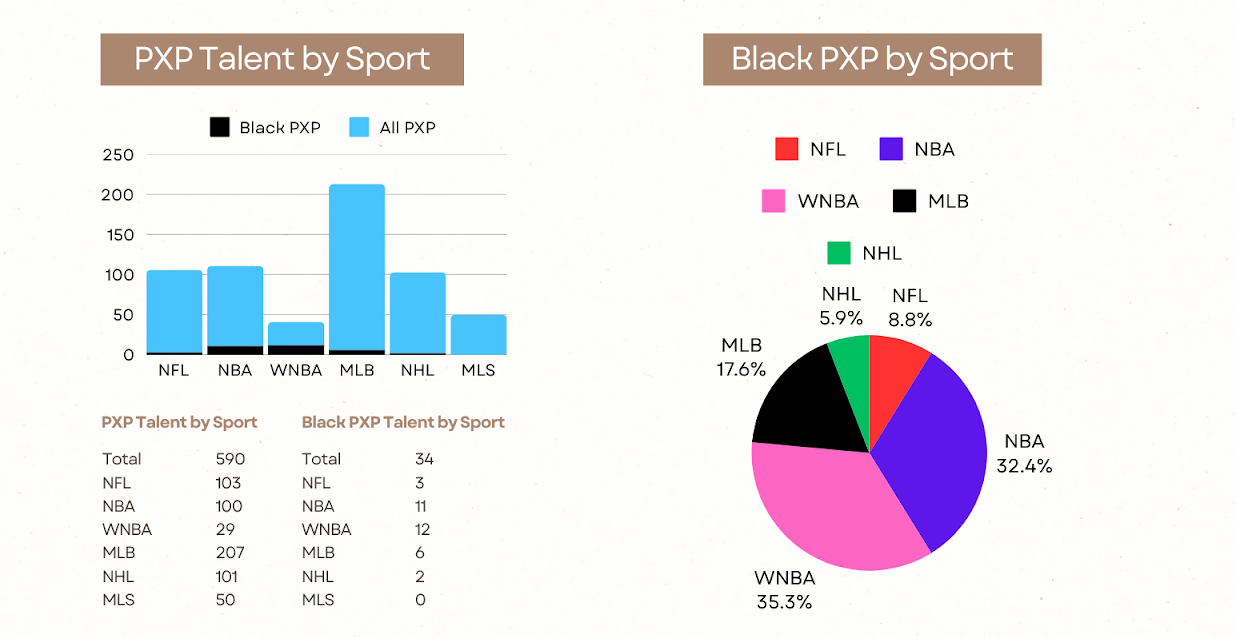Less Than 6% of PXP Talent are Black
Study shows less than 6% of Black PXP broadcasters across 6 US major sports leagues
The Black Play-by-Play Broadcaster Grant & Scholarship Fund conducted a study across the major US professional team sports (NFL, NBA, MLB, NHL, WNBA, MLS) that shows of the 590 number of professional play-by-play positions, a total of 34 or 5.8% are occupied by Black broadcasters.
What the findings mean
The figures show the lack of participation in the lead broadcasting seat by Black professionals, despite making up 13% sports fans, according to a 2024 study about the demographics of die-hard sports fans by Media Culture. That figure is in line with the 2020 U.S. Census data that show Black people comprise 13.7% of the United States population.
These headline figures also stand in stark contrast to the demographics of NFL and NBA players in particular. 53% of NFL players are Black, while 70% of NBA players are Black, according to Statista reports from 2023. Only 3% of NFL play-by-play broadcasters are Black, while that figure is 11% for NBA play-by-play broadcasters.
“These numbers simply show what we’ve always known, which is that there’s an underrepresentation of Black people in the play-by-play booth,” said Adam Giardino, veteran play-by-play broadcaster and Executive Director of the Black Play-by-Play Broadcaster Grant & Scholarship Fund. “Clearly there’s no lack of interest in sports or in the sports industry. The numbers only reaffirm why our organization exists – to invest in the next generation of broadcasters and provide resources as their careers get off the ground.”
What comes next
The numbers reflect the top of the broadcasting industry, where 75% of broadcasters are over the age of 40 with 36% of broadcasters reaching a tenure of 5+ years, according to Zippia figures about the sports announcer industry. While the demographics of the play-by-play industry won’t change significantly in the next 5-10 years - as broadcasters in these top-of-the-industry roles generally stay in these seats for decades - the mission of the Black Play-by-Play Fund is to set up the next group of broadcasters for success.
“It should be pretty obvious, but it’s important to note that our goal is to help young Black broadcasters be ready to answer the call when new talent is needed, not to replace anyone currently in seat,” said Darius Thigpen, former play-by-play broadcaster and Board Member of the Black Play-by-Play Fund. “Generally speaking, it’s a tough industry to break into. It’s a competitive industry, these are contract positions that don’t open up often, and there isn’t much guidance for those trying to navigate. Entry-level wages are low and usually quite far from home. Networking matters a lot. People outside of the industry don’t always have an understanding of the difference between an analyst or commentator role, often occupied by a former athlete, and the play-by-play chair. If nothing else, we want to ensure all the young Black sports fans out there to appreciate and understand that play-by-play is absolutely a skill they can develop and that we’re here to help. This is particularly salient for Black women who want to get into play-by-play, as we only have a handful of Black women in those seats.”
The Black Play-by-Play Fund will continue to monitor the demographics of the play-by-play industry. This includes future analyses that include the demographics of play-by-play broadcasters in college sports and developmental leagues, such as the NBA G-League and Minor League baseball.
Breakdown by sport
Methodology
Data for the report gathered from publicly available information. Sources include:
Team websites
Network broadcaster announcements
Wikipedia’s lists of current broadcasters by sport
Each broadcaster listed in position is as of late 2024. The report does not account for the likelihood of job changes between the time of analysis and writing.
The list of broadcasters was gathered at several levels:
By sport
By network OR team
By medium (TV or radio)
By ethnicity
The above reporting includes certain broadcasters (example - Mark Jones for ESPN and for the Sacramento Kings) in multiple roles to reflect local work, national work, TV and radio work, and work across multiple sports. This was done intentionally in order to show the total number of play-by-play roles across the sports and the percentage of those roles that are occupied by Black broadcasters.
The study only included English-language broadcasts for networks distributed within the US and or local markets for each team.
For questions or media inquiries, please contact darius@blackpxpfund.com

